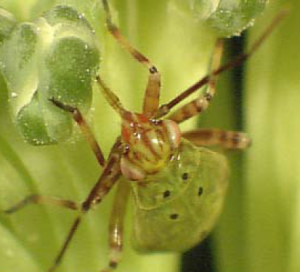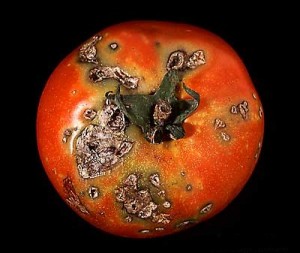 One of our most important competitors for food, fiber, and other natural resources, since time immemorial, has been insects. These pests have a direct impact on agricultural food production as they cause damage by chewing the leaves of crop plants, sucking out plant juices, boring within the roots, stems or leaves, and spreading plant pathogens. Every year millions of dollars are lost because of insect damage in agriculture. One such pesky creature, contributing to this damage is the lygus bug. Lygus bug also called tarnished plant bug, is a destructive oval-shaped insect that causes serious damage in fruit orchards, herbaceous plants, vegetable crops, commercial flower plants, and nursery stock.
One of our most important competitors for food, fiber, and other natural resources, since time immemorial, has been insects. These pests have a direct impact on agricultural food production as they cause damage by chewing the leaves of crop plants, sucking out plant juices, boring within the roots, stems or leaves, and spreading plant pathogens. Every year millions of dollars are lost because of insect damage in agriculture. One such pesky creature, contributing to this damage is the lygus bug. Lygus bug also called tarnished plant bug, is a destructive oval-shaped insect that causes serious damage in fruit orchards, herbaceous plants, vegetable crops, commercial flower plants, and nursery stock.
Lygus bug has a wide host range of more than 350 plants! In general, lygus bug prefers grains, vegetables, and weeds near crops. When lygus bugs are present in high numbers, seed set and maturation may be reduced by nearly 100%. These pests inject toxic saliva into the plant and cause seed structures to die and drop off the plant. Even moderate feeding can cause premature bud shed, deformed seeds and reduced seed viability. Injured seeds will turn brown or black and will not germinate. In western Canada, lygus bugs reduced yields by approximately 7%; while in southern Manitoba, yields were reduced by almost 20%!
 Lygus bugs, while infesting fruits like peaches, pears and strawberries, may cause dimpling, also known as catfacing. Lygus bugs also cause fire blight disease, which they spread throughout the area as they feed. This disease causes the flowers to turn brown and wilt and twigs to shrivel and blacken, often curling at the ends. In more advanced cases of fire blight infection, cankers begin to form on branches. These discoloured oozing patches contain masses of fire blight bacteria and heavy infections can be fatal. It was reported that in one field near Glendale, United States, about 90% of the cotton crops, valued at $16,000,000, was destroyed through the attack of this insect.
Lygus bugs, while infesting fruits like peaches, pears and strawberries, may cause dimpling, also known as catfacing. Lygus bugs also cause fire blight disease, which they spread throughout the area as they feed. This disease causes the flowers to turn brown and wilt and twigs to shrivel and blacken, often curling at the ends. In more advanced cases of fire blight infection, cankers begin to form on branches. These discoloured oozing patches contain masses of fire blight bacteria and heavy infections can be fatal. It was reported that in one field near Glendale, United States, about 90% of the cotton crops, valued at $16,000,000, was destroyed through the attack of this insect.
This article published in The Western Producer will highlight the severity of the damage caused by the lygus bug.
Alberta at high risk for lygus bugs
Posted on Aug. 1st, 2014
By Barbara Duckworth
Brooks, Alta. — It is time to start sweeping canola fields for Lygus bugs.
This summer’s heat, with temperatures at or above 30 C, is encouraging faster reproduction of the damaging insects, said Scott Meers, an entomologist with Alberta Agriculture.
“This year will be a high risk for lygus. You should start sweeping,” he said.
Two or more bugs captured per sweep means it is time to spray, he told a Canola Galla education day held at Alberta Agriculture’s Crop Development Centre at Brooks.
“I expect we are going to get into the typical race between harvest and lygus damaging the crop,” he said.
Adults and larvae suck plant juices so that flowers abort and pods fall off. Feeding on the older pods causes the seeds to shrivel or the pods to be deformed.
Alberta Agriculture is monitoring 311 sites along Highway 2 down the center of the province. The department has found Lygus bugs as well as plenty of bertha armyworms and a few diamondback moths. However, the monitoring has found no Swede midges.
In some years, spraying for cabbage seedpod weevils will also catch Lygus bugs, but it is not uncommon to have to spray lygus twice.
“We don’t want to encourage prescription spraying, but if you spray for cabbage seedpod weevil, then the general trend is that if we get the timing right for cabbage seedpod weevil, then we seldom have trouble with lygus,” he said.
 The most common tool used to manage Lygus bugs are insecticides. However, besides being extremely toxic and harmful to the environment, most insecticides used for lygus control will destroy beneficial insects which help keep whiteflies and other pests in check. Moreover, studies show that the more exposed the bug is to the insecticide, the more resistant the bug will be. In spite of that, insecticide application was the only option available for the control of Lygus bugs once populations reached economic threshold levels, until now.
The most common tool used to manage Lygus bugs are insecticides. However, besides being extremely toxic and harmful to the environment, most insecticides used for lygus control will destroy beneficial insects which help keep whiteflies and other pests in check. Moreover, studies show that the more exposed the bug is to the insecticide, the more resistant the bug will be. In spite of that, insecticide application was the only option available for the control of Lygus bugs once populations reached economic threshold levels, until now.
Now, we no longer have to depend on these conventional, toxic insecticides to deal with these pests! C Tech Corporation offers a range of non-toxic, non-hazardous anti-insect aversive, which can be successfully used to keep pesky creatures at bay.Combirepel™ is a broad spectrum aversive which works against almost 500 species of damaging insects. The most appealing feature of this product is that it is an environment-friendly repellent which causes no harm to the target or the non-target species! It is available in masterbatch and lacquer form and as a liquid solution. Thus, by incorporating Combirepel™ in agricultural films and mulches, crops would be efficaciously protected against these menacing insects!
Combirepel™ is available in the form of the masterbatch, liquid concentrate, and lacquer. OurCombirepel™ masterbatch can be used in polymer base applications like wires, cables, irrigation pipes, polymeric vessels, and other various applications.
Combirepel™ liquid concentrate can be mixed in the paints to cover the areas like cracks and crevices of walls and hidden places where the roaches tend to survive.
Combirepel™ lacquer is the topical coating to cover the places like bathrooms, cupboards, steam tunnels, etc.
Hence we provide you with the best effective solution.
Contact us as technical.marketing@ctechcorporation.com to get solution on pest nuisance.
Also, visit our websites:
http://www.ctechcorporation.com/
http://www.rodrepel.com/
http://www.termirepel.com/
http://www.combirepel.com/
Follow our Facebook pages at:
1] https://www.facebook.com/Combirepel-411710912249274/
2] https://www.facebook.com/Termirepel-104225413091251/
3] https://www.facebook.com/Rodrepel-120734974768048/
Follow us on our Twitter pages at:
1] https://twitter.com/rodrepel
2] https://twitter.com/termirepel
3] https://twitter.com/combirepel

